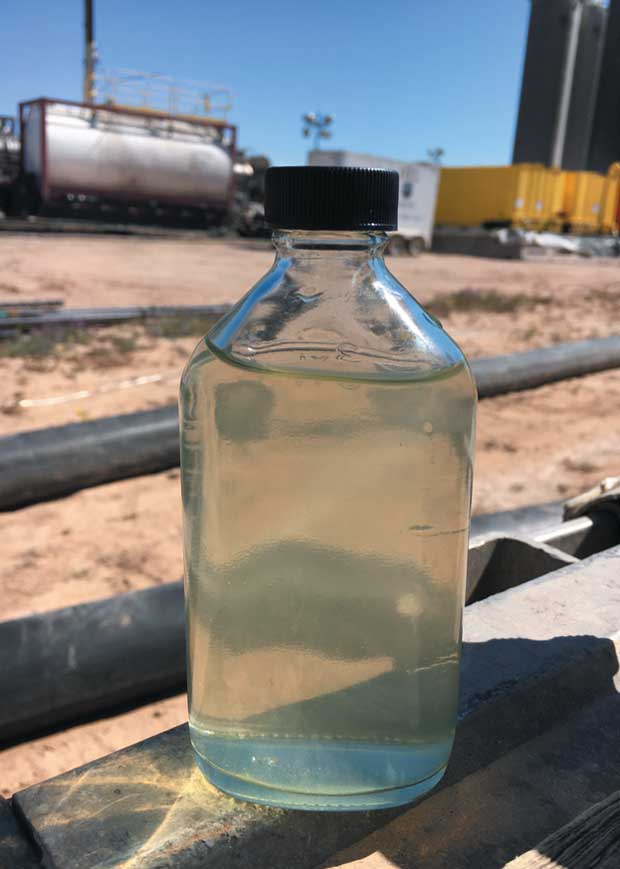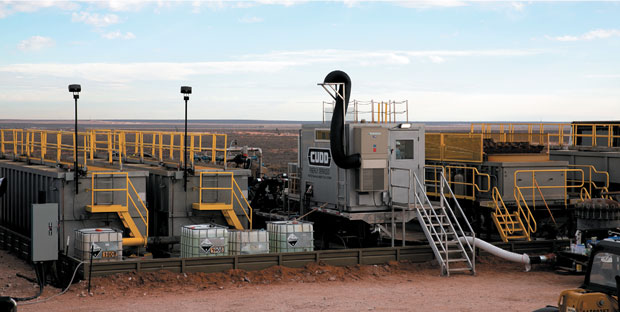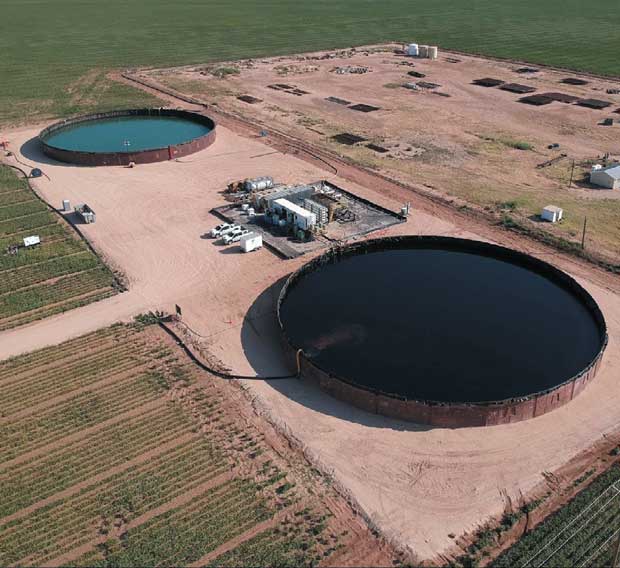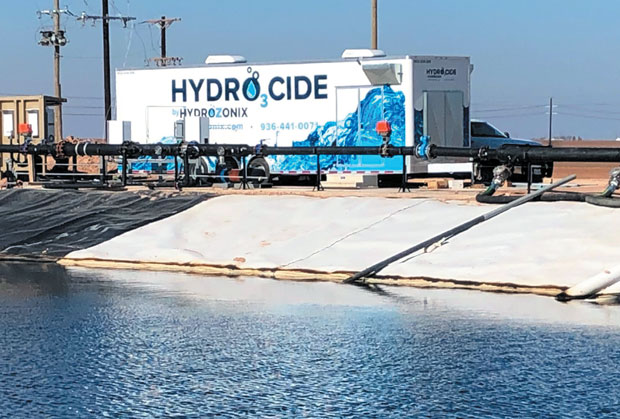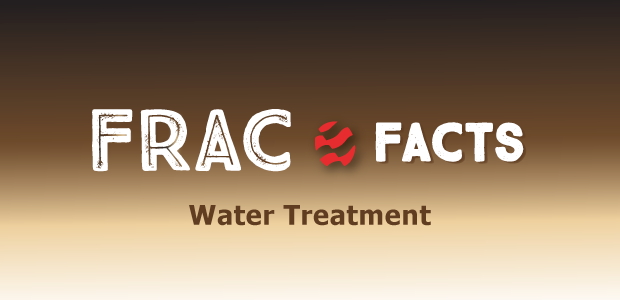
Water Recycling Strengthens Permian
By Colter Cookson
For every barrel of oil produced in the Permian Basin, there are at least two barrels of water. In the Delaware Basin, some wells lift 10 barrels of water for every barrel of oil, according to Wood Mackenzie.
As produced water volumes grow, disposal wells become harder and more expensive to permit. At the same time, both public and private investors increasingly push the industry to minimize its impacts on the environment, including freshwater supplies, while continuing to practice fiscal restraint and deliver strong returns.
Recycling produced water is one way for operators to achieve both financial and environmental goals. According to completion consultants and water management experts, this reality has supported technological innovations that enable operators to transform more produced water into effective completion fluids.
“It is becoming easier to justify completing wells with produced water,” assesses Dustin Aro, vice president of operations and co-founder of the consulting firm Precision Petroleum Solutions. “The vast majority of unconventional completions rely on slickwater to stimulate the reservoir. Chemical providers have met the challenge of high chloride source water by developing robust friction reducers that limit produced water’s impact on pumping rates. This lets us deploy sufficient horsepower without major changes in well construction or stage spacing.”
“In West Texas, produced water recycling can mitigate rising costs to dispose of produced water and acquire freshwater,” Aro continues. “The surge in activity has highlighted water as a major line item, but operators still need to pump high volumes because barrels of water per foot influence well productivity alongside pounds of proppant per foot. By easing water sourcing’s burden on completion AFEs and disposal’s effect on lease operating expenses, recycling can help operators meet production targets without squeezing margins.”
Water treatment has become efficient enough for recycling produced water in completion fluids to offer attractive returns even for small projects, Precision Petroleum Solutions reports. For example, this treated produced water came from a five-well program in the Delaware Basin.
Reusing produced water can offer attractive economics even for extremely small operations, Aro says. As an example, he cites SPE-204166-MS, a paper he presented at the Hydraulic Fracturing Technology Conference that discussed why and how a Delaware Basin operator recycled produced water for a five-well program targeting the Wolfcamp B and C.
“The operator had a great deal with the midstream company and an on-lease disposal transfer skid, which is rare for small operators, so the produced water disposal costs were about $0.50 a barrel,” he recalls. “Even so, it was more economic to build a produced water pit and complete four wells using 100% produced water.”
Aro estimates the pit paid for itself once produced water had been used to complete 10,000 feet of lateral. For operators with more expensive disposal costs, which can reach as high as $3 a barrel, he says the economics can be even more compelling.
“When I talk with small operators about recycling produced water, the pit construction costs can cause sticker shock,” he comments. “However, when we compare the operator’s freshwater acquisition and produced water disposal costs to the ones for recycling, the pit often makes sense as long as the operator has the resources to think beyond 30-60 days.”
Evaluation
To evaluate whether recycling will work for a specific project, Aro suggests producers start by tallying how much produced water their wells generate and looking at water samples from those wells to determine the water quality, which affects treatment costs. “Operators with multiple producers and multiple benches should test all of them in case the water properties differ,” he advises.
The next step is flow loop testing with friction reducers to verify their compatibility with the produced water. “This testing is a great starting point, but we ultimately discover what works in the field,” Aro remarks. “For example, in the Delaware Basin case study I mentioned earlier, we found out that a basic friction reducer worked as well as a more expensive one at our rates and pressures by alternating FRs from stage to stage.”
In almost every application, Aro recommends building a produced water pit rather than sourcing water from a saltwater disposal line. “With a pit, the operator can treat the water to the desired quality before sending to site,” he says. “With a hot tap, the water quality can shift rapidly because there are an unknown number of wells that produce from several benches flowing into the SWD pipeline.”
The completion crew can try to normalize the quality by testing the water periodically and adjusting dosage rates or the ratio of produced water to freshwater, but Aro cautions that getting this right can be tricky. “I have been on sites where we see pressure spikes in the middle of a stage from water quality changes,” he says. “When that happens, we have to ask ourselves whether the spike came from the surface or the rock. Water from a pit eliminates that uncertainty and the water quality guessing game associated with on-the-fly treatment.”
Between digging the pit, installing the liners, putting in an aeration system, and getting power to the pad, Aro says it can take 45-90 days from the time a pit is shovel-ready to it being full and ready to supply a completion.
Construction companies can build a pit of any size, but Aro says most people favor round numbers, such as 500,000 or a million barrels. He says, “To size the pit, operators project how much water their wells will produce so they can calculate how quickly the pit will fill. That should be compared with the drilling and completion program’s demand for water to make sure the pit can keep pace. I have been on locations where it couldn’t and the frac job had to stop.”
Growing Volumes
As completion designs have evolved, the volume of water that needs to be moved to the well pad has grown, observes Enrique Proaño, vice president of water management solutions for Cudd Energy Services. “A completion crew that is working a standard two-mile lateral zipper with 60 stages per well and pumping 12,000 barrels a stage likely averages about eight stages a day,” he relates. “That means the pad will need 96,000 barrels a day, or 720,000 for each well.”
While job sizes have begun to stabilize, Proaño predicts that each pad’s water needs will continue rising as completion efficiency improves. He says the move from zipper fracs to simulfracs is a particularly striking example, as it involves going from alternating wells to completing two at once.
“To get the necessary water volumes at a reasonable cost, many operators use a mix of freshwater and produced water or 100% produced water, with the exact ratio depending on availability,” Proaño notes. “Over time, the percentage of produced water has grown as friction reducers have become robust enough to be effective in high TDS water.”
According to Proaño, one of the biggest questions facing the industry is what level of treatment is needed before sending water down hole. “We are not clear on how water quality affects the reservoir,” he acknowledges. “When do we need to remove all the oxidizable species and most of the solids from water, and when can we get away with using almost raw water that only has a biocide and perhaps a scale inhibitor?”
That is a difficult question because low-quality water’s effects on production can take years to manifest, Proaño says. “We have tried comparing production from wells completed with various water qualities, but even when we can see a difference, it can be hard to determine whether water quality is the cause, given the considerable variation in lateral lengths, stage counts, proppant concentrations, frac fluid designs and other elements.”
Proaño adds that completion techniques evolve so quickly that in the rare cases historical data offers a good comparison, it may no longer be relevant.
Biocides’ Role
Despite the challenges of tying results to completion chemistry, Proaño says the industry has learned effective biocide treatment is important in most wells. “We have long known that bacteria can lead to hydrogen sulfide, which reduces the hydrocarbons’ quality and causes safety issues and corrosion,” he notes. “Today, we understand how downhole bacteria growth affects production.”
Proaño references an SPE-sponsored study about bacteria growth in structures that resemble fractures. “The researchers estimated that bacteria growth caused a 20% loss of conductivity in the fracture system,” he summarizes. “Controlling bacteria is an area where we want to spend the right amount of money.”
To prevent bacteria growth that can reduce fracture network conductivity, Cudd Energy Services recommends including biocides in completion fluids that not only address surface bacteria, but also offer long-term protection down hole.
Biocides can range in price from a couple cents a barrel for the most basic biocides to $0.10-$0.15 a barrel for more robust programs, Proaño reports.
“We have a steep learning curve to climb in understanding dosing requirements,” he adds. “Many operators rely on the old rule of thumb that they need a quarter gallon of biocide for every thousand gallons of water, but that dosing may be inadequate for many wells. The ideal dosage rate differs from well to well and reservoir to reservoir, and often changes throughout development of the field.”
With oxidative biocides, Proaño says it is easy to test waters for demand and residual biocide concentrations during the completion process to verify the bacteria in the water have been mitigated. He indicates field tests with conventional biocides are not practical.
Treating surface waters is not enough. “Bacteria can be reintroduced to the water when it is mixed with proppant,” Proaño warns. “To further complicate matters, bacteria that are indigenous to the reservoir can bloom after the frac because friction reducers and other completion chemicals have nutrients that stimulate their growth.”
To address downhole bacteria, many operators use biocides that can survive and remain effective for an extended period. “One of the challenges with these long-lasting biocides, which can be called extenders, is that many were designed for freshwater. They work well in that environment, but they lose most or all their potency in brines. Others get absorbed into the shale rather than staying in the water,” he says.
Cudd has a proprietary biocide that retains its potency even in high TDS water, Proaño mentions. He says the base chemistry originates in the aerospace industry and has been used widely in the pharmaceutical and food and beverage sectors.
“We are extremely proud of this technology, one of the few biocides in the market that can provide both short- and long-term protection at an affordable cost,” Proaño says. “Additionally, we are working with microbiologists to develop next-generation formulations that should be even more effective.”
Sampling’s Importance
Treating produced water efficiently but effectively requires thorough sampling, says Coby Reynolds, a Midland-based chemical engineer with SwiftWater, a TETRA Company.
“Even in an area as well-understood as the Permian Basin, produced water quality can vary widely,” he explains. “A treatment process that works well on water from one formation or bench may prove inadequate if it is applied to a new area without confirming the water quality is similar.”
Reynolds stresses that treatment plans should be based on samples from several water sources. “One of the most common mistakes we see is designing an entire program around one sample, even though most of the water that will end up in a frac pond comes from different zones, wells and areas,” he says. “This can lead to significant problems.
“To understand how, remember that during completions, there is always a chance the well will connect to and begin producing from an unintended zone,” he continues. “If that zone happens to be the Bone Springs, the flowback from the well might have 2% H2S, which can be hazardous and has a huge effect on how the water needs to be treated.”
This TETRA Technologies Inc. recycling facility processes as many as 50,000 barrels of water a day. Through automation, the company says it has significantly reduced the costs, safety risks and environmental footprint associated with water recycling operations.
To minimize unnecessary treatment costs, Reynolds advises operators to limit how long water sits in pits. “The longer the water is in the pit, the more time bacteria and other contaminants have to grow,” he warns. “Produced water tends to be warm and salty, so it is a friendly environment for the sulfate-reducing bacteria that create H2S.”
By introducing ambient oxygen to the water, aeration systems can make the pond hostile to SRBs while supporting more benign aerobic bacteria. These bacteria generally have more aggressive lifecycles than SRBs and often outcompete them for nutrients.
“When evaluating aeration systems, look for systems with small bubble sizes rather than focusing solely on turnover and volume,” Reynolds suggests. “Smaller oxygen bubbles tend to spend more time entrained in the fluid column and spread throughout the pond, which makes them more effective at controlling SRBs and promoting desirable bacteria.”
Automation’s Ascent
TETRA Technologies and SwiftWater are performing almost all their jobs with automation through a proprietary automated control system, says Dean Fanguy, TETRA’s director of business development for the Western Hemisphere. He describes the system as a cloud-based dashboard that takes control of the water management process to help ensure safe and successful operations.
“At automated sites, we have gone from needing 12 people on site to two. This has reduced labor costs, as well as expenses associated with vehicles and housing,” he reports. “On some projects, our clients are saving 30%-50% on fuel because the equipment is only operating when it needs to and only running at the speed necessary to do the job.”
The automation system is enhanced by a mobile app that allows anyone involved in the project, including customers, to monitor the operation and make changes remotely.
“We also have a line walker app for auditing our pumps and water transfer lines on a route,” Fanguy shares. “There are prompts for operators that they can customize to check different functionality of the equipment. If something around the line changes or something looks like it may become an issue, the app makes it easy to snap a photo and alert others so it can be addressed.”
As part of its quest for efficient and sustainable operations, Fanguy says TETRA is working with many of its operators to electrify centralized recycling facilities that will be in use for several years. “It’s fascinating to go to these sites,” he comments. “There are no engine emissions, and even when the facility is handling 100,000 barrels of water a day, it’s quiet.”
The company’s innovation teams are developing ways to reuse produced water outside the oil and gas industry or to return it safely to the environment, Reynolds adds. “Given how much produced water wells generate, figuring out how to do that is essential for the industry’s long-term health,” he says.
Refining Processes
COVID helped accelerate a move toward more efficient water treatment facilities, says Mark Patton, president of Hydrozonix. “We wanted to make productive use of our time when activity fell, so we focused on improving our processes,” he recalls. “We were able to completely automate our recycling facilities’ day-to-day operations. They still need maintenance techs to visit once a week, but they otherwise are monitored remotely.”
According to Patton, the key to maximizing automation is simplifying processes, including replacing chemical processes with mechanical ones wherever possible. “Chemicals have to be replenished, which means people need to be on site more frequently,” he explains.
By streamlining and automating its processes, Hydrozonix has enabled many of its operations to be performed remotely. The company says this improves safety while reducing emissions by minimizing how often workers need to drive to and from the site.
It’s also vital to minimize open top tanks and pressure vessels, Patton emphasizes. “One of the reasons many facilities have people on site is to respond in case open-top tanks overflow or pressure vessels leak,” he says. “We have float gauges inside our containment that will turn everything off if a spill starts to occur and cameras on many of our systems so we can see what is going on remotely.”
In 2020, Hydrozonix also automated the water treatment systems it deploys to help operators prepare completion fluids at the frac site. “During pilots, we had someone on site log how often he interacted with the system. He almost never did, but at least in the short term, customers want a person on site to answer questions.
“We are starting to see that change as companies look for ways to reduce their carbon footprints, including the number of people who have to drive to and from the pad,” Patton reports. “To ensure they still can get answers quickly, our systems have buttons that call live operators.”
Evaporation
In the long run, the industry will need alternatives to recycling or injecting produced water, Patton argues. “Today, the industry generates almost three times as much water as it uses for completions. Even at our peak hydraulic fracturing activity, we still generate twice as much,” he says.
The excess normally would go to underground injection wells, Patton notes. “However, disposal well costs are going up. It takes longer to get a permit, and because of concerns about induced seismicity, the newer permits in Texas give the Railroad Commission the flexibility to restrict wells’ capacity or shut them down if there are seismic events.”
Patton says these permits leave “seismic event” undefined, which can make it difficult to assess the risk a well will need to operate below capacity.
Evaporation is one alternative to injection. “Operators have been looking at evaporation but are reluctant to do it because conventional systems can leave salt dust in the area. This occurs when wind picks up the spray the systems produce before it evaporates and deposits the salt in and around the pond.”
Hydrozonix has a patent-pending system designed to evaporate water in large pits while controlling where the spray drifts, Patton says. “The system monitors humidity and wind direction so it can adjust flow rates through the nozzles to ensure the water evaporates above the pit,” he clarifies. “This reduces evaporation efficiency but allows evaporation to be used without depositing salt outside the pit.”
As part of a full-scale field pilot, Patton says, Hydrozonix tested the soil for salt accumulations on all four sides of the pit every week. “Based on the data from that field trial, another operator is deploying the system in Oklahoma, which has less salty produced water but higher wind speeds,” he relates. “We also are in discussions with other companies.
“We think interest in evaporation will grow as operators look for alternatives to disposal wells, but it is not a silver bullet,” Patton assesses. “Evaporation rates are higher in summer than in winter, and if an area gets a lot of rain, no evaporation will occur. Evaporation is not the most flexible tool, but it is cost-competitive with disposal wells and can be done in areas without enough completion activity to enable recycling.”
External Use
In five or 10 years, Patton predicts the industry will have the technology and legal framework needed to discharge produced water for agriculture and other applications. “We are seeing positive movements, with some people in Texas working on applications,” he reports. “Given the scarcity of water in West Texas and southeastern New Mexico, that is great news.”
Patton says becoming a generator of usable water as well as a producer of energy would bolster the industry’s already-strong environmental, safety and governance profile. “We have a fantastic story to tell, because the energy we produce is essential to peoples’ quality of life,” he says.
Liberty Oilfield Services Inc.’s 2020 ESG report captures that story well, Patton remarks. “One of the report’s most striking photos shows the boundary between the oil-dependent Dominican Republican and Haiti. The Dominican side is lush and green, but the Haitian side is barren because people there have to use wood for fuel.”
For produced water discharge to be acceptable, the industry and regulators will need to address health and environmental concerns, Patton acknowledges. “Many people assume we need to know everything in water to discharge it safely,” he says. “That seems logical at first glance, but most industries–including municipal water plants–discharge under a more practical framework centered around general toxicity tests and thorough treatment processes.”
One of the challenges with the “quantify everything” approach is that no tests exist for many produced water constituents, Patton comments. “The New Mexico Produced Water Consortium is moving quickly to figure out what is in produced water and to develop tests to quantify it,” he says. “The consortium’s work should help eliminate many of the barriers to broader water reuse.”
For other great articles about exploration, drilling, completions and production, subscribe to The American Oil & Gas Reporter and bookmark www.aogr.com.














